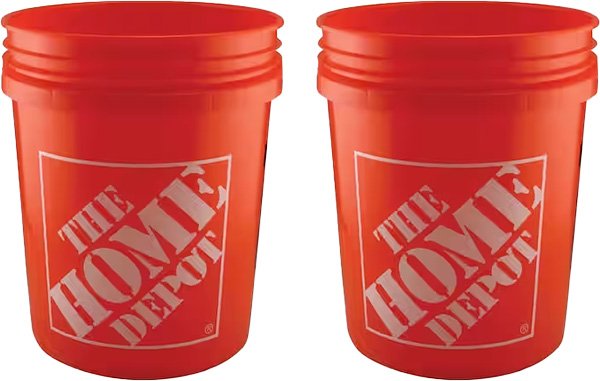
If you buy something through our links, ToolGuyd might earn an affiliate commission.
Home Depot Homer buckets are great for holding lots of things, but they’re not food-grade.
Yes, these buckets are made from HDPE (high density polyethylene) and have a #2 recycling symbol.
Yes, HDPE is used in food-grade products. But that doesn’t make these buckets food-grade.
Leaktite, the manufacture, says (with added line breaks for improved readability):
The #2 symbol does not necessarily mean the bucket is food-safe. Virgin, or non-recycled, HDPE is food-safe, but if that cannot be guaranteed, the bucket should not be labeled as such.
Our products are more geared toward paint and DIY so we do not FDA certify.
The buckets we label as food-safe are run on a segregated machine and use virgin HDPE.
Currently, we only offer white as food-safe; they will be called out with a food-safe sticker. The orange buckets also have colorant that is not tested as food-safe which adds another level of uncertainty.
So, HDPE can be used in the production of food-grade containers, but not all containers made from HDPE can be considered food-grade.
Products made from recycled HDPE have the potential to be food-grade, but require testing and close monitoring to meet FDA guidelines. The FDA, in their guidelines for the use of recycled plastics, says:
The possibility that chemical contaminants in plastic materials intended for recycling may remain in the recycled material and could migrate into the food the material contacts is one of the major considerations for the safe use of recycled plastics for food-contact applications.
The FDA’s document is 21 pages long and discusses all the things needed in order for products made from recycled plastic to be considered food-grade.
Leaktite says that their food-grade buckets are explicitly labeled as such, and that their food-grade buckets are made from “virgin HDPE” materials.
Is there harm in using non-food-grade buckets? I don’t know. The dye could leach out – and definitely fades and breaks down when exposed to outdoor conditions and UV light. And as the FDA mentions, there could be chemical contaminant residuals from the use or recycled materials.
I use food-grade buckets for planting fruits and vegetables, although not so much anymore after moving to grow bags and raised beds. I also use them for bulk food prep and to make fermented pickles.
Some of my planter buckets didn’t have drain holes, as I had used them with self-watering reservoirs. Fermentation creates a highly acidic and high-salt environment. A couple of dollars extra for food-grade buckets made me feel more comfortable.
When it comes to food grade considerations, you can’t just make assumptions. It’s either food-grade, or it’s not. And in the case of buckets and pails, food-grade containers are advertised and labeled as such.
Rather than wonder about the potential for safety concerns, I feel it’s better to simply go with food-grade buckets when the differences might matter.
There’s a lot of misinformation online. You can’t just look at the recycling number code. That can tell you if a container is made from a plastic used in food-grade containers, and not whether the container itself is food-grade.
If in doubt, ask questions. Leaktite answered dozens of questions about Home Depot’s iconic orange Homer bucket, each time saying in different ways that no, these buckets are not food-grade.
If you want a food-grade bucket, you have to buy one that’s advertised or labeled as such.

Leaktite’s food-grade buckets have a special label with a spoon, fork, and knife.
Are food-grade buckets safe? That depends on the application. Personally, I feel it’s a far better starting point than buckets whose food contact safety is not certified, advertised, disclosed, or labeled in any regard.
Home Depot and Lowe’s both have food-grade buckets in white.
There are other manufacturers as well; Uline sells food grade plastic buckets in a rainbow of colors. (I like that Uline’s are thicker – they have a 90 mil wall thickness vs 70 mil.)
I have only ever seen food grade buckets made from HDPE. Polypropylene seems to more common for thinner-wall bulk food prep containers.
Shopping Links:






